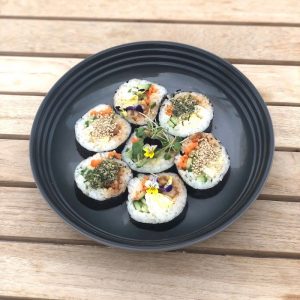|

In the midst of the pandemic, vaccinations, stimulus packages, and the start of spring, you might understandably have missed it. In case you didn’t know, Miss Kim is now serving brunch every Saturday and Sunday morning. We’re offering a whole range of great dishes, all rooted in or connected to Korean culture, that make for a wonderful way to start your day. To learn more about it, I asked Ji Hye to share one of her favorites. She chose Kimbob, which turns out to be a wonderful example of how cultures develop. Here’s what Ji Hye had to say:
I love digging into the history of food and the story of each dish. I read about the first documented stories of a dish and how it evolves into what we know today, and it is like watching a movie. I imagine different periods, the people, their settings, environment, and stories, and it is a lot of fun.
Korean kimbob is a sort of rice roll, akin to Japanese maki sushi. When I was growing up, it was the unofficial food of picnics and field trips in Korea. Mothers get up early on the day of children’s field trip day, preparing multiple ingredients for the filling and taking time to roll out each roll, slicing it to bite-sized pieces and packing it neatly into lunch boxes with a bit of extra pickled radishes. During lunch time, I would sit with a bunch of friends and we would all open our lunch boxes, sample each other’s kimbob, and comment on subtle differences. True to my mother’s unwavering pride in her cooking, she would scoff at quick-and-easy ingredients like fish cakes and imitation crab meat. She would insist on simple ingredients she made from scratch. I would blindly follow her belief and secretly felt superior in my mother’s kimbob, but I was too polite to criticize. I suspect every child feels this way about her mother’s kimbob, though.
More than a couple of people have suggested that I make kimbob at Miss Kim, but it felt paradoxically difficult to me. It can be technically challenging, from the numerous components in kimbob to the technique of rolling it just right. Even though it is similar to Japanese maki rolls, it is not considered as elevated. I was also hesitant because I thought the history of this dish was fairly short in Korean cuisine. When we started doing brunch, I thought maybe this was a fun place to start.
When I read about food with a long history and tradition, I often find that the need for preservation drives old recipes and that different people often come up with similar solutions to that need. This is the case with Korean kimbob, and Japanese sushi, too. Both started out as preserved fish dishes. Local fish is salted and fermented with grains—most often millet and rice—and becomes Korean sikhae and Japanese narezushi. What’s interesting is that the Japanese took narezushi and continued to evolve it into what became sushi today, especially with the production of vinegar. Vinegar aided with the need for preservation, the long fermentation process was abandoned in favor of vinegared rice and fish. You see the evolution that started with long fermented narezushi to what looks more like sushi of today during the Edo period in the 1800s. Sushi rolls in particular were developed for convenience, often by the street vendors, for workers, laborers, and gamblers, since wrapping the rice and fish with dried seaweed made it possible to consume it quickly without utensils. It continued to evolve into luxury food, especially with the sushi masters seeking the best ingredients and techniques. It sort of makes me chuckle a little that food developed for long preservation and convenience is now one of the most luxurious and costly foods around.
In Korea fermentation is still one of the most prized and studied techniques of the cuisine, and fermented fish develops in a different direction. Sikhae, the fermented fish in rice and millet, still is enjoyed very much as a delicacy, and Korean markets carry an array of fermented seafood and fish sauce from numerous types of seafood. Kimbob shows up again during the Japanese colonization period in the early 1900s as a take on Japanese sushi rolls. You can find newspaper articles suggesting it for picnics for its convenience, just like I had when I was a child during field trips. Even today, kimbob is most commonly a familiar sort of food sold in convenience stores like 7-Eleven, street stalls, and outdoor markets. These days, Koreans are really making it their own though. There are kimbob specialty stores with a big menu of different fillings, like candied dried anchovies, Korean fried chicken, uni, and foie gras.
I took inspiration from all this and made our kimbob with Tracklements’ Miss Kim-cold-smoked salmon, a little Korean omelet, and vegetables. It’s seasoned with sesame oil and salt, so that’s what we do as well. With pickled radishes, burdock, and red onions, the nuttiness of sesame strikes a nice balance. I hope you come by for brunch and give it a try.
Miss Kim brunch is available Saturdays and Sundays in May, 10am–1pm.
|
Zingerman’s Art for Sale